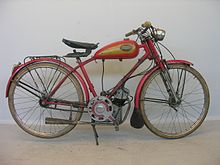Ducati
It was finally destroyed by around 40 Consolidated B-24 Liberators on 12 October 1944 as part of the United States Army Air Forces's Operation Pancake, which involved some 700 aircraft flying from airfields in the Province of Foggia.Barely a month after the official liberation of Italy in 1944, SIATA announced its intention to sell this engine, called the "Cucciolo" (Italian for "puppy," in reference to the distinctive exhaust sound) to the public.The first Cucciolos were available alone, to be mounted on standard bicycles, by the buyer; however, businessmen soon bought the little engines in quantity, and offered complete motorized-bicycle units for sale.This first Ducati motorcycle was a 48 cc bike weighing 98 lb (44 kg), with a top speed of 40 mph (64 km/h), and had a 15 mm carburetor (0.59 in) giving just under 200 mpg‑US (1.2 L/100 km; 240 mpg‑imp).When the market moved toward larger motorcycles, Ducati management decided to respond, making an impression at an early-1952 Milan show, introducing their 65TS cycle and Cruiser (a four-stroke motor scooter).Despite being described as the most interesting new machine at the 1952 show, the Cruiser was not a great success, and only a few thousand were made over a two-year period before the model ceased production.In December 2005, Ducati returned to Italian ownership with the sale of Texas Pacific's stake (minus one share) to Investindustrial Holdings, the investment fund of Carlo and Andrea Bonomi.Volkswagen chairman Ferdinand Piëch, a motorcycle enthusiast, had long coveted Ducati, and had regretted that he passed up an opportunity to buy the company from the Italian government in 1984.Analysts doubted a tiny motorcycle maker would have a meaningful effect on a company the size of Volkswagen, commenting that the acquisition has "a trophy feel to it," and, "is driven by VW's passion for nameplates rather than industrial or financial logic".Taglioni chose this emblem of courage and daring as a sign of respect and admiration for Francesco Baracca, a World War I fighter pilot who died during an air raid in 1918.[17] In addition to manufacturing two-wheelers, Ducati also assembled Triumph Heralds for sale in the Italian market in their Borgo Panigale plant beginning in early 1963.Its angular lines were unique, but raised handlebars made for an uncomfortable seating position at high speeds and also caused steering issues.In 1994, the company introduced the Ducati 916 model designed by Massimo Tamburini,[24] a water-cooled version that allowed for higher output levels and a striking new bodywork that had aggressive lines, an underseat exhaust, and a single-sided swingarm.Ducati has produced several styles of motorcycle engines, including varying the number of cylinders, type of valve actuation and fuel delivery.Ducati has also made other engine types, mostly before the 1970s, with one, two, three, or four cylinders; operated by pull rod valves and push rod valves; single, double and triple overhead camshafts; two-stroke and even at one stage manufactured small diesel engines, many of which were used to power boats, generators, garden machinery and emergency pumps (for example, for fire fighting).In North America there are several Ducati enthusiasts organizations with varying degrees of factory sponsorship, such as the Bay Area Desmo Owners Club (BADOC) located in and around the city of San Francisco, CA.[39] Ducati's history with motorsport began with speed records on Cucciolo motorized bicycle factory racers in 1951, followed in 1954 with bringing in Fabio Taglioni to found a road-racing program with the 100 Gran Sport.In 2007, MotoGP reduced the engine size to 800 cc (49 cu in), and Ducati continued to be the fastest with a bike that was markedly quicker than its rivals as was displayed by Casey Stoner on tracks with long straights.In the AMA Superbike Championship, Ducati has had its share of success, with Doug Polen winning the title in 1993 and Troy Corser the following year in 1994.Big enough for Ducati to team with Italian specialty builder NCR to craft a limited-edition update, New Blue, based on the 2007 Sport 1000S, and big enough to inspire the crew at the Barber Vintage Motorsports Museum (see Barber Motorsports Park), arguably one of the most important motorcycle museums in the world, to commission Ducati specialist Rich Lambrechts to craft a bolt-by-bolt replica for its collection.










Ducati (company)Ducati (disambiguation)SubsidiaryMotorcycleBolognaNet incomeParentLamborghiniDivisionsDucati CorseVolkswagen Groupvacuum tubescapacitorsBorgo PanigaleConsolidated B-24 LiberatorsUnited States Army Air ForcesProvince of FoggiaTurinesepushrodengine for mounting on bicycles"Cucciolo"carburetorDucati Mach 1motor scooterMach 1V-twin enginesdesmodromic valveCagivaTexas Pacific Groupinitial public offeringInvestindustrialFerdinand PiëchIstituto per la Ricostruzione IndustrialeTexas-Pacific GroupAutomobili Lamborghini S.p.A.AUDI AGMotoTransDucati PaulSmart 1000 LEfour-strokespringswet clutchesdry clutchestrellis frameDucati MuseumFabio TaglioniPantahDucati SuperSportFerrariFrancesco BaraccaDucati singlesDucati ApolloTriumph HeraldsDucati L-twin engine860 GTGiorgetto GiugiaroDucati Desmoquattro engineDucati PasoMassimo TamburiniDucati 916MV Agusta F4Bimota DB1Miguel Angel GalluzziDucati MonsterPierre TerblancheDucati SupermonoPaul Smart750 Imola DesmoSportClassicStreetfighterPaul Smart 1000LESuperSport 750, 900, 1000Desmosedici RRDucati HypermotardDucati Desmosedici RRDucati 1098 S TricoloreMonsterMultistradaDiavelPanigaleSuperSportHypermotardScramblerDesmodromicdual ignitionDesmoquattroV-twin engineV angleproduct differentiationtwo-stroketiming beltcamshaftsingle-cylindervalve floatSupermonoparallel twinDesmosediciApolloTumi Inc.luggagefactory racersGrand Prix motorcycle racingCasey StonerDucati Marlboro TeamNicky HaydencustomerPramac RacingMika KallioNiccolò CanepaValentino RossiDucati TeamAndrea DoviziosoCal CrutchlowAndrea IannoneMichele PirroJorge LorenzoYamaha Factory RacingFrancesco BagnaiaDucati Desmosedici GP22Ducati Desmosedici GP23Raymond RocheDucati 851Doug PolenDucati 888Carl FogartyTroy CorserDucati 996




